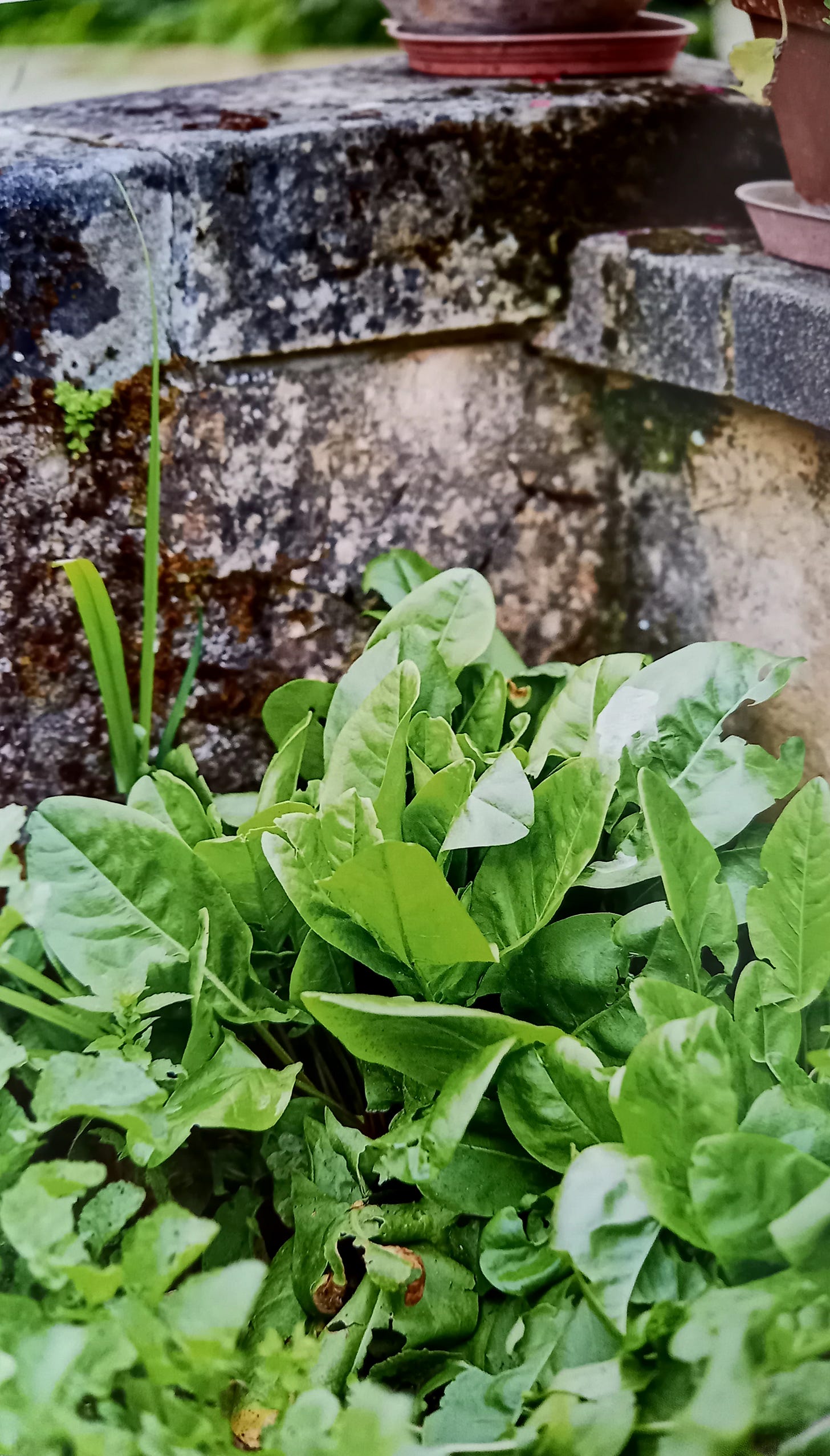Sorrel is a vegetable thoroughly worth growing yet few people do. Given how popular is its use in palate-tingling French sauces this is a pity, since it’s not all that easy to find in supermarkets or farmers’ markets. It reappears in the ground without fail every year from April to September, in a clump that increases annually. It doesn’t mind being grown in poor soil and is even perfectly happy being raised in a large flower pot.
We’re talking about common sorrel here, Rumex acetosa, not to be confused with ‘sorrel of the Caribbean’, Hibiscus sabdariffa, that gorgeous red flower used to make sour tea, juice, jams and jellies. Sorrel's name originates from the Germanic word “sur”and the old French word “surele,” both of them meaning “sour.”
Cultivated as a perennial herb, sorrel has a history traceable back to the ancient triumvirate of Greece, Egypt and Rome where it was used for its high acidity to balance rich and heavy foods. Oseil in French, sorrel can be foraged for in the wild in common grassland though it’s probably best to leave it in place if the field is used by animals and pets.
Most commonly associated in the mind of Europeans with French recipes, it’s used in the cooking of a surprisingly wide spread of nations. In India it’s used in soups and curries, as it also is in Vietnam. In Greece it’s added with spinach to spanakopita, the pie of leeks, spinach and feta cheese wrapped in phyllo pastry. In Albania, the leaves, first simmered and marinated in olive oil, are used with herbs in burek pies. In Romania, Hungary, Russia, and Ukraine* (scroll down for a Ukrainian soup recipe and fund-raising initiative link), sorrel is added to egg or meat dishes or soups, and stewed with vegetables. The Afghans often use sorrel leaves dipped in batter then deep fried as a break fast during Ramadan. The Armenians weave whole plants into braids and dry them for winter use in a popular soup of potatoes, onions, walnuts, garlic and bulgur wheat or lentils. In Nigeria, sorrel is common in stews and steamed along with roasted peanut cakes, tomatoes and onions.
Yet while used broadly and quite frequently mentioned by Henry David Thoreau in his book ‘Walden’, sorrel has only recently been adopted by contemporary American chefs.
Its leaves look similar to dock, which gives it its other English names: narrow-leaved dock, spinach dock, arctic dock and patience dock, along with sheep sorrel, and broad-leaved and red-veined sorrel.
As well as bringing a sour edge to sauces, soups and stews, it’s a nutritious plant, high in fibre, magnesium, vitamins C and A, antioxidants, and other micronutrients. It is used medicinally, to treat liver problems, aid digestion, and cure throat and mouth ulcers. However, if you’re allergic to rhubarb, buckwheat or knotweed, don’t eat it. Sorrel is part of that same large family. Equally, because it’s rich in oxalic acid, people suffering from rheumatism, kidney stones, arthritis, gout and heartburn should avoid it.
While the leaves are best picked young, if they have matured the fibrous stalk needs to be discarded. With the fingers of one hand grasping the stem, lightly draw the leafy green upwards between thumb and forefinger, then abandon the stalk or throw it into a pot of soup you plan to puree and sieve. Baby leaves or torn larger leaves can be added raw to a salad for a vibrant lemony kick.
It’s that lemon taste which makes it so attractive for flavouring rich cream or butter sauces to go with fish or chicken or egg dishes. If you add actual lemon juice to such a sauce, it’s likely to curdle the cream. But when using sorrel, if you’ve made sure you’ve first heated the cream in a separate pan before incorporating the sorrel, there’s less possibility of curdling the cream and the sorrel will add that lemon tartness without the danger.
Sadly, its lovely grassy green turns to a grungy shade of khaki as soon as the leaves are exposed to the hot melted butter, or cream, or boiling stock that recipes call for. But its bright flavour compensates for the loss of colour.
Like spinach, what looks like a generous bunch will wilt down to a miniscule amount, so buy or pick much more than you believe is necessary. Fresh sorrel sauce needs to be used at once as it won’t keep well. But since you can freeze it, it’s worth making a large amount of it to divide into small portions to bring out when you don’t have time to tizzy up a piece of fish or a breast of chicken with other more involved culinary tricks.
What you mustn’t do is cook it in any copper or copper alloy pan. As with spinach, the acid sorrel contains doesn’t just cause the metal to leach into the food but it also erodes the pan’s tin or stainless steel surface lining.
To alter the flavour of a Potage Bonne Femme leek-and-potato soup, once those vegetables have softened, add a generous handful or more of finely sliced shreds of sorrel leaf and stir them in until they have broken down.
A sorrel sauce makes a particularly good companion to a fillet of salmon. Just steam a thick slice until assumes a light rosy translucence in the middle (you don’t want that sawdust texture of a conference catering salmon; but check out Harvey's comment in St Patrick's Day shenanigans for safety guidance) and lay it on a puddle of the sauce. If you can't source sorrel, spinach will substitute. But order some seeds to sow for your own supply.
155ml/5¼fl oz cream
3 tablespoons unsalted butter
115g/9oz sorrel leaves, stems removed
2 tablespoons Noilly Prat vermouth, or chicken or vegetable stock
Salt and white pepper to taste
Pile a few sorrel leaves on top of one another and roll them up like a cigar. Slice them across in thin strips. Bring the cream to a simmer in a small pan.
In a separate pan, heat the butter over medium heat. Add the sorrel and wilt it, stirring often, until it collapses. Stir in the cream and bring to a low simmer. Add the vermouth and stock to thin it out to the consistency you want. Season with salt and white, not black, pepper. Pour over a steamed fillet of fish or prawns or grilled chicken breast - or steamed new potatoes.
*Breaking news…
In a pure coincidence, Ukraine-born food writer Olia Hercules has published a Ukrainian Sorrel soup recipe in The Guardian today, 17 March, to highlight a UNICEF fundraising initiative: https://www.theguardian.com/food/2022/mar/12/olia-hercules-springtime-recipes-green-borsch-nettle-garlic-soup-cauliflower-fritters-cook-for-ukraine-campaign?utm_term=623329cc15de3ad2b9becc6245392a40&utm_campaign=WordOfMouth&utm_source=esp&utm_medium=Email&CMP=wordofmouth_email





My mother used to make a classic Eastern European dish called schav, a cold sorrel soup served with sour cream and slices of hard-boiled egg. Refreshing on a warm day.
Sorrel is practically the national soup of Latvia. Latvians use chicken broth and potatoes and a couple of chopped hard cooked eggs and dill as a garnish, and then add the obligatory dollop of sour cream. After escaping the Soviet occupation, my aunt had a Latvian friend mail seeds from Latvia to plant in the US.